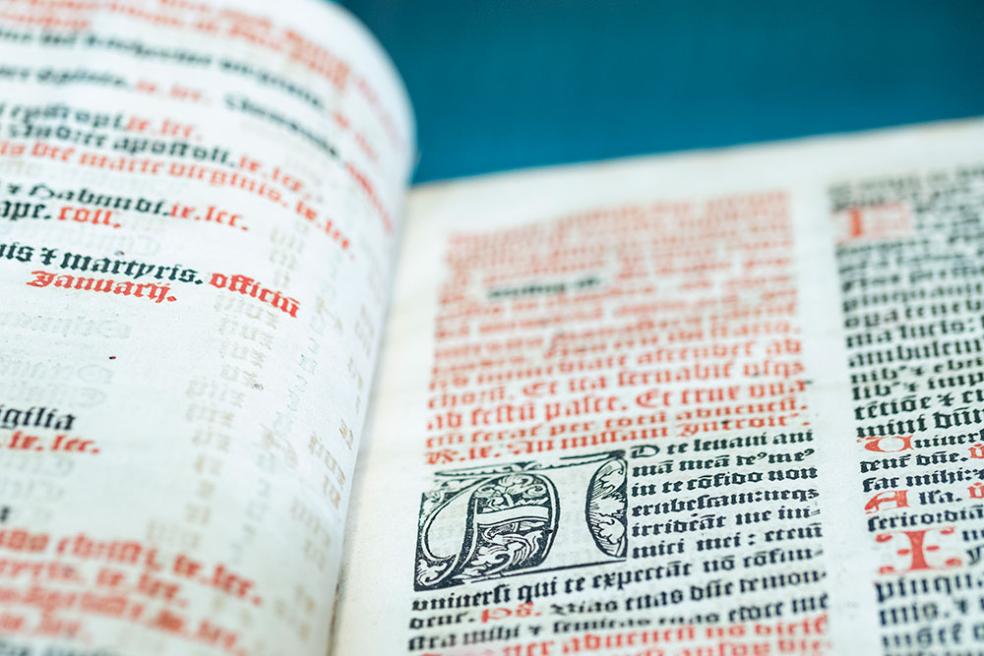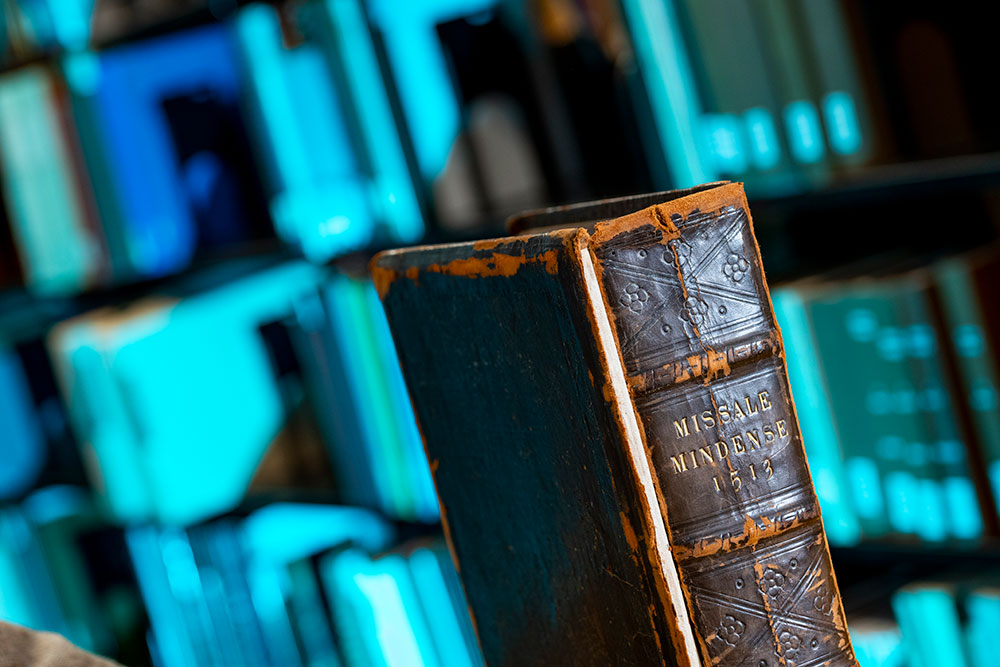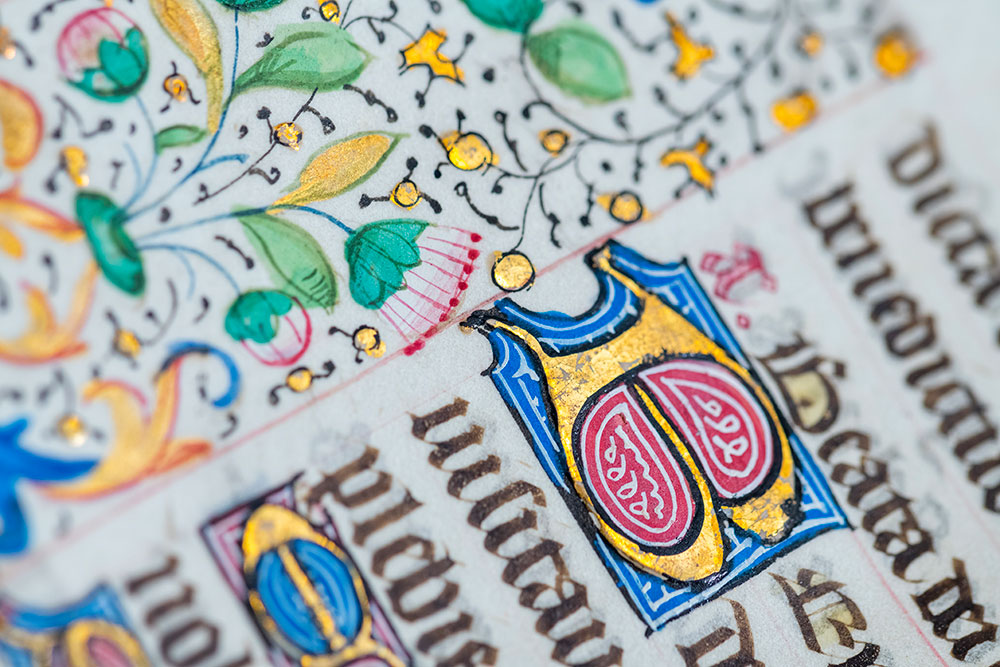
At more than 500 years old and sitting in strikingly good condition in the University’s rare books collection, Missale Mindense is the oldest book at the Library. It was made in Germany in 1513 using woodblock printing, the oldest form of printmaking, according to the Metropolitan Museum of Art. The process uses wooden blocks that were hand carved and painted, then pressed onto paper.
Missales are religious texts whose names derive from the Latin term for “Mass.” As its name implies, these act as instruction books for Roman Catholic services, which priests and parishioners read songs or prayers out of. The first of these liturgical books popped up in the 13th century, according to the U.S. Conference of Catholic Bishops, marking the first official attempt at a uniform celebration of the Mass. Several variations of missales exist; some for personal use, some for Sunday mass, others are specific to certain regions, time periods, or saints, and new editions were released throughout the centuries.
While worshipers have used missales for hundreds of years and into the modern day, one of the most famous uses for the book was to inaugurate a U.S. president in 1963. According to reports, President John F. Kennedy famously carried a missale; his missale was mistakenly used instead of a Bible to swear in President Lyndon B. Johnson after Kennedy’s assassination.
Bound in leather, and strewn with book worm holes, the Missale Mindense is written entirely in Latin in a gothic script style that evokes the Middle Ages. While its journey here is unknown, it was likely donated to the library several decades ago. Faint remnants of a name plate remain but any identification of its previous owners does not.
Many people aren’t able to read Latin. “But folks love coming in to see it and say, ‘I touched something from the 1500s today,’” says Sarah Godlin, the University’s archivist and digital publications specialist.
Certainly antiquitous, the missale isn’t the oldest text in the collection. That title goes to a set of three manuscript leaves (six pages) from the Book of Hours, printed in the 1400s.
The leaves were painstakingly handmade and painted with gold. Like the Missale Mindense, the Book of Hours is a devotional text, and among the most popular of the time period—thanks to the influence of the Catholic Church in Europe during the Middle Ages. The leaves, like many of the books in Cal Poly Humboldt’s collection, were also donated.
To help preserve these books, they are kept in cases—some of them in acid-free archival boxes—in an environment-controlled room. Many of these books are on display, and students and members of the public are welcome to visit the collection and take photos.
“The special collection tries to be as approachable and user friendly as we can,” says Godlin. “We’re more than happy to share it.”
The collection also includes hundreds of rare texts about local history, art, nature, counter culture, and more. Some of those include “The Psychedelic Experience,” co-authored by Timothy Leary; “The Yosemite” by John Muir; and one of Godlin’s personal favorites, “Composition Couleurs Idees” published in 1930 and created by Sonia Delaunay, co-founder of the Orphism art movement.
One of the most unique inclusions in the collection is “Hough's Encyclopedia of American Woods.” The set of 16 books from the 1950s features hundreds of samples of actual woods with different cuts.
While age may be one factor contributing to a book’s rarity, this isn’t always the case. “Rare books can be brand new books too,” says Godlin.
For example, one of the rarest texts in the collection is the chronic freedom series. The series was published in 2011 by author Scott Holmquist. It chronicles the cannabis movement in Southern Humboldt. It contains five books that represent a single, unified work.
One book features tent canvases and pages made from soil bags; another is pierced with a bullet and strewn with headlines and accounts about the regional cannabis industry. A third book is presented in a light box of locally-sourced wood and items from outdoor grows, with pages inserted into a turkey oven bag.
Only 10 sets of the series exist. In addition to the Library’s special collection, it’s also featured in the J. Paul Getty Museum in Los Angeles, and in the Library of Congress’ Rare Books and Special Collections.
“The University’s Special Collections keeps so much history about Humboldt County and the surrounding areas,” Godlin explains. “You don't need any reason to visit and pore over the collections that focus on the natural resources, native peoples and primary industries of North Western California. There is a good deal of University history here as well, and we are ever-digitizing.”

Missale Mindense

The Book of Hours